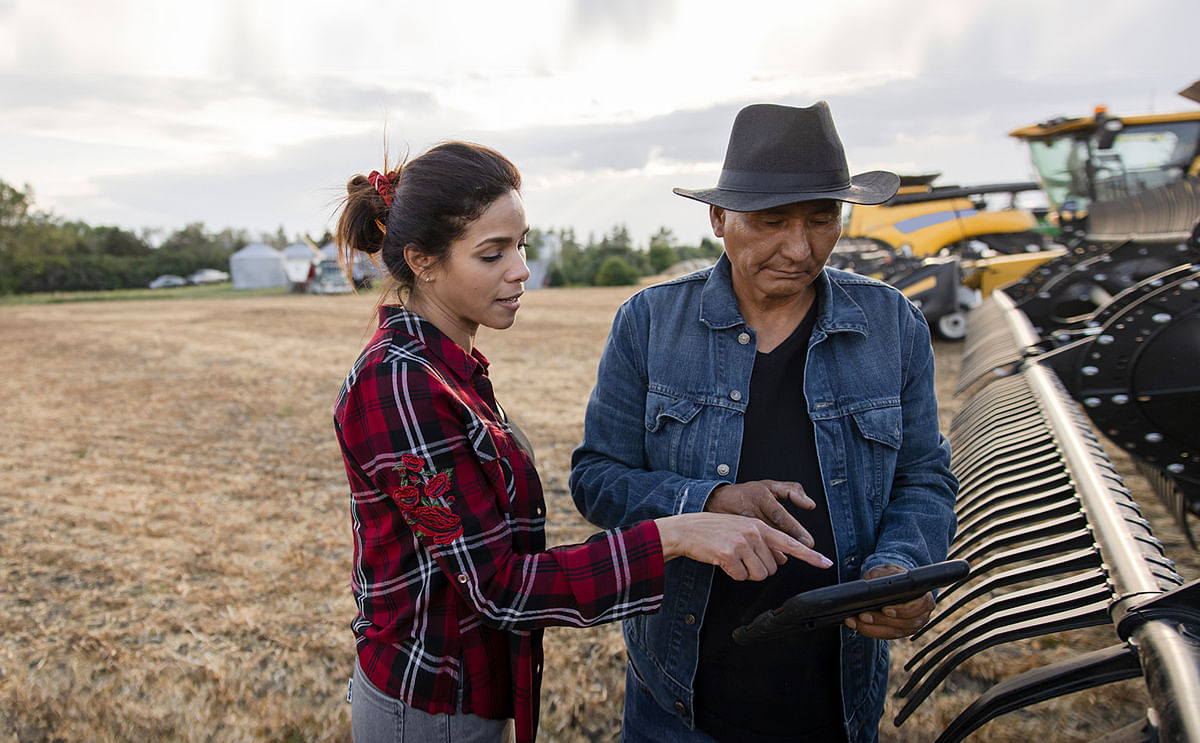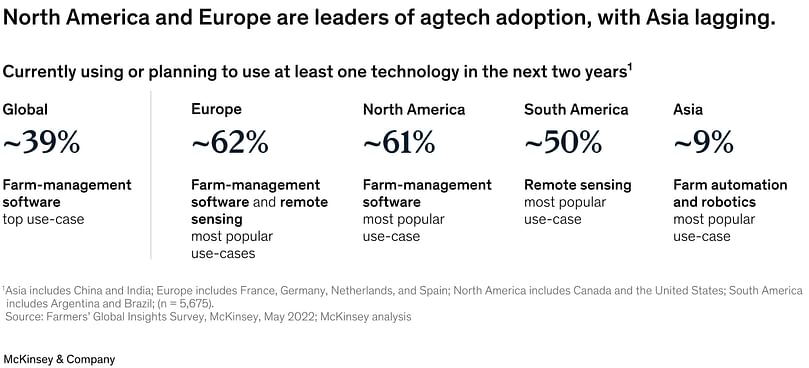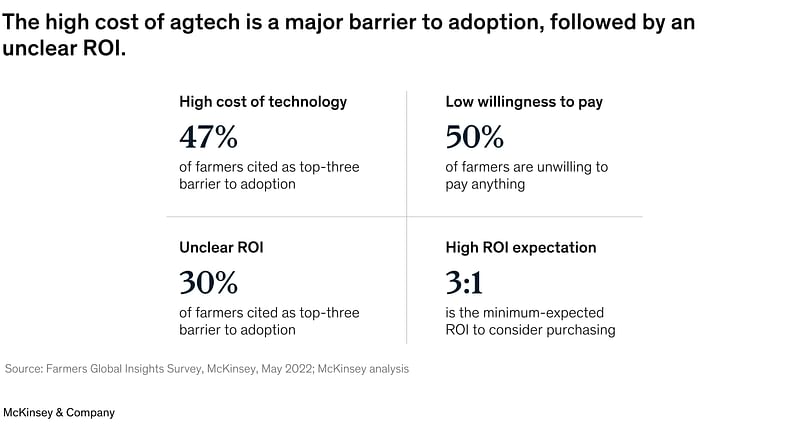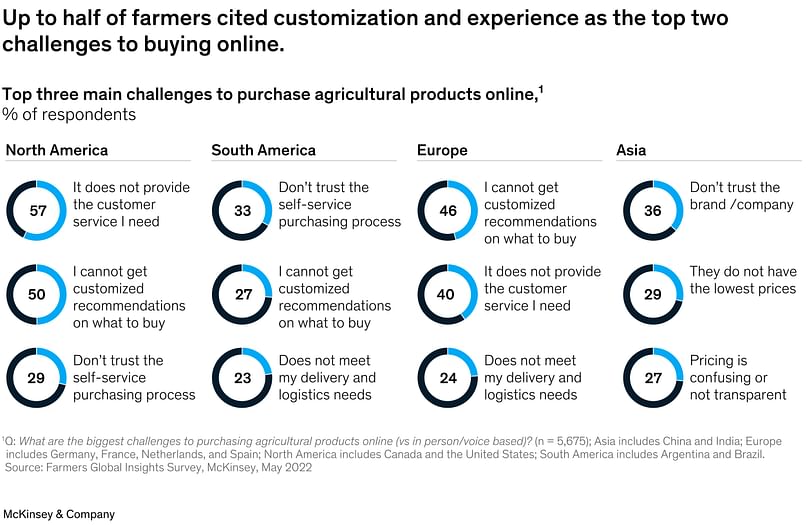Agtech: Breaking down the farmer adoption dilemma
Agtech: Breaking down the farmer adoption dilemma

With recent increases in on-farm profitability and strong investments over the last decade, there is a high openness to innovation, yet adoption is slow.
On one hand, most farmers have benefited from the macroeconomic tailwinds of global commodity cycles; in 2021, on-farm income in many regions was at its highest level in almost a decade and was projected to remain at near record highs in 2022.
On the other hand, inflationary pressures are mounting and farmers are facing an onslaught of challenges—having to scrutinize weather forecasts, be aware of shifts in the regulatory landscape, or face evolving consumer preferences, rising costs from inflation, and unreliable supply chains.
Meanwhile, external capital has been pouring into the upstream agriculture food-technology industry to the tune of about USD 18.2 billion in 2021, an approximate 38 percent year-on-year growth since 2013.
This influx of capital has brought with it a plethora of technological solutions to the agriculture space. Over the past decade, the number of farmer-facing agtech start-ups has ballooned. Farmers can now harness software, hardware, and service-based solutions that promise to increase efficiency, ease pain points, and lower their environmental footprint.
Even with need driving funding availability, agtech start-ups are struggling to scale. In our recent publication on agtech funding over the last decade, they showed that most deals are occurring in the Seed and Series A rounds.
Far fewer start-ups, however, are receiving later-stage funding or going public, suggesting that agtech start-ups are not able to build the requisite customer base to transition to these funding rounds.
Current global agtech adoption: survey
In some areas, agtech solutions are already driving the next level of farm productivity by reducing operational costs and enabling less resource-intensive growth.
To gain a deeper understanding of how agtech usage may differ across regions globally, and what barriers may be impeding broader adoption, we surveyed 5,500 row- and specialty-crop farmers in 2022 across Asia, Europe, North America, and South America.

North America and Europe are leaders of Agtech adoption with Asia lagging
Farmers in Europe, while also most concerned about high costs (48 percent), report complexities in setup and use as an additional major barrier to adoption (32 percent). Farmers in South America (50 percent) follow in agtech adoption, with differences in adoption observed between countries within each region.
South American farmers are the most apprehensive about trust in the purchasing process through online platforms (33 percent). Agtech product adoption is lowest in Asia, with only about 9 percent of farmers using or planning to use at least one agtech product; adoption varies between countries in this region as well.
Looking at agtech submarkets, farm-management software has the highest adoption among farmers at 21 percent, followed closely by a 15 percent utilization of remote-sensing and precision agriculture hardware.
Sustainability-related technology (such as software and hardware that measure carbon emissions and sequestration, and monitor and optimize irrigation systems), and automation and robotics—technologies that are still in their infancy—lag at about 5 percent adoption.
Over the next two years, limited growth is projected across categories, with roughly 4 percent of farmers saying they plan to adopt either farm-management software, precision-agriculture hardware, remote-sensing solutions, or sustainability-related technologies, while additional automation and robotics adoption is projected to be slightly lower, at around 2.5 percent.
Five trends emerge within the agtech space
Five trends arise across six farmer-facing agtech submarkets. (See "Six major farmer-facing agtech submarkets.")
Some trends are cross-cutting, while the impact of others is disproportionate across certain agtech submarkets:
- Though agtech adoption is slow, farmers are open to innovation.
- There is a transition toward more sustainable, less resource-intensive food systems, with precision agriculture as a key enabler.
- Regulation will likely play an increasingly important role in accelerating growth in certain agtech submarkets.
- Business models continue to evolve toward integrated solutions.
- There is opportunity to improve product personalization and resolve the limited trust around data sharing.
Openness to innovation
Shifting pressures are leading farmers to be more open to agtech innovations as potential tools to optimize their returns and minimize their financial risk. Thirty-nine percent of farmers surveyed globally are currently using or planning to use at least one agtech product in the next two years.
To improve their bottom lines, 43 percent of surveyed farmers are focused on trying new products to increase yield, while almost a quarter (22 percent) are planning to change purchasing and vendor strategies.
Rising input prices are currently the greatest worry that farmers face, with 67 percent citing increased input prices as one of their top three concerns for profitability over the next two years.
Their unease is well-founded, as farmers globally report that their input prices have risen between around 80 percent and 250 percent in the last few years. South American farmers have been the hardest hit (at about 247 percent), while Asia’s input costs (around 82 percent) are the least affected.
Though farmers are currently producing food under elevated sales price conditions, the volatility of the commodity markets—combined with rising input prices—introduces great uncertainty on future profitability.
As past economic cycles have shown, the delay in time between input production, purchase, and application means that a dip in commodity prices does not immediately mirror a drop in input prices, adding strain to farmers’ bottom lines.
Farmers are thus motivated to offset this uncertainty by optimizing their yields—an opportunity to introduce agtech innovations to their farming strategies.
Across all markets, large farms—more than 5,000 acres—are the most willing to adopt agtech solutions (81 percent), with 76 percent of medium farms (2,000 to 5,000 acres) and 36 percent of small farms (fewer than 2,000 acres) using or planning to use at least one technology in the next two years.
Agtech adoption is not uniform across regions and, in some cases, there is substantial variation between countries within regions—both in terms of the percentage of farmers using agtech, and the agtech submarkets they adopt.
Farm-management software is the most common submarket among North American farmers. In South America, remote-sensing technology is the highest use case (23 percent), and Brazilian farmers outpace Argentinian farmers in adoption across most agtech submarkets.
European farmers show considerable variation by country, as well as within submarkets. For example, agribusiness marketplace adoption is highest in Germany at 13 percent, whereas precision-agriculture hardware usage is highest in the Netherlands at 33 percent. In Asia, farmers in India currently use more agtech products than those in China across all submarkets.
European farmers show considerable variation by country, as well as within submarkets. For example, agribusiness marketplace adoption is highest in Germany at 13 percent, whereas precision-agriculture hardware usage is highest in the Netherlands at 33 percent. In Asia, farmers in India currently use more agtech products than those in China across all submarkets.
Instead of targeting the adoption of individual agtech solutions, the current environment is likely to encourage farmers to focus attention on combining two key submarkets: farm-management software systems and precision-agriculture hardware solutions. These two innovations work in concert to optimize fertilizer and pesticide usage and tailor seeding rates.
Farm-management software systems are particularly promising because they can equip farmers with the information needed to evaluate and manage how they utilize large value pools, including inputs such as fertilizers, seeds, and pesticides.
These systems are further enhanced when precision-agriculture hardware solutions are deployed to conduct input application in the field. For example, optimizing input application through variable rate applications, especially when coupled with advanced guidance systems and automatic shutoffs, gives farmers greater control at preventing site-specific over-application.
Transition to more sustainable food systems
As the physical and economic impacts of climate change worsen, global consumers and investors are turning to sustainable food systems.
McKinsey’s recent article on conscious eating shows that nearly 30 percent of respondents have increased their consumption of more sustainable food products since the start of the COVID-19 pandemic.
Additionally, our most recent analysis of agtech funding in 2022 indicated that nearly one-third of start-ups have a sustainability-focused value proposition. This suggests that both start-ups and investors are responding to these changes in consumer preferences and broader societal trends.
However, results from our survey show that the direct adoption of agtech has yet to align with investor and consumer sentiment—such as sustainability-related technologies and those that support the transition to more sustainable farming practices.
Europe and North America lead the use of sustainability-related technology, but at 9 percent adoption, there is opportunity for agtech to grow in these regions. There is also growth opportunity in other parts of the world, with only a 6 percent adoption rate globally.
Even where adoption of sustainable farming practices is higher, use of sustainability-related technologies is still low.
For example, as shown in our "Global Farmer Insights 2022" survey, Brazil is a leader in the use of biologicals (55 percent) and low-till practices (83 percent), though its adoption of sustainability-related technology is as low as 10 percent.
Precision-agriculture hardware, which is a major driver for sustainable, low-emission farming practices, is utilized the most in North America (28 percent), followed closely by South America (27 percent), and Europe at 21 percent.
The solutions showing the most enthusiastic adoption are yield mapping and monitoring software (69 percent), variable rate fertilizer-application technology (67 percent), and automatic sprayer-section shutoffs (67 percent). Asia is still catching up, with only 4 percent adoption of overall sustainability-related technology categories (Exhibit 2).

Within precision agriculture-hardware, farmers are leveraging variable rate fertilizer application in conjunction with yield mapping at high rates
This includes measuring soil organic carbon to verify carbon sequestration—for many carbon programs, for example, three to nine years’ worth of historical data are required depending on crop rotation.
Sustainability-related technologies that support measurement, reporting, and verification (MRV), as well as data-collection technologies such as remote sensing, are starting to address the burdensome data requirements and will likely play an important role as farmers transition toward more sustainable practices.
Regulation’s increasingly important role
Regulation already plays a critical role in shaping the future of agtech—our survey data show that government-sponsored programs are the main drivers of sustainability-program adoption, with about 40 percent of farmers reporting that they participate in these initiatives.
Regulatory changes proposed over the past three to five years in various countries are likely to affect the direction of agtech adoption and innovation. For example, Europe’s proposed Green Deal (parts of which focuses on overall reduction and exposure to agricultural inputs) is widely expected to have a moderating impact on farmers’ fertilizer and pesticide usage.
There are also proposed changes to Canada’s 2030 Emission Reduction Plan that aim to lower emissions from fertilizer application. These are likely to drive the adoption of agtech innovations such as farm-management software solutions and precision-agriculture technologies—alongside a shift toward using inputs with lower greenhouse-gas emissions.
In practice, agtech solutions have the potential to support farmers in optimizing the application of high-emission inputs. For example, high-resolution fertility mapping, when coupled with variable-rate applications of fertilizer, can both optimize and increase productivity of fertilizer usage and prevent over application.
The combination of AI-backed machine vision and automatic nozzle shutoffs on GPS-guided spray equipment can also significantly maximize the efficiency of herbicide application and prevent costly overlap.
In addition to concerns about biodiversity loss and water pollution through the overuse of chemical fertilizers, a pertinent issue affecting farming globally is the collision of rising global temperatures and declining freshwater pools—both visible and underground. Water management is likely to gain more attention, receiving increasing societal and regulatory pressure.
New solutions can be found in agtech to address freshwater usage and waste from agricultural practices. For example, remote-sensing technologies that detect plant health or stress, soil-moisture sensors that communicate with irrigation systems, advanced weather-forecasting solutions, and the software interfaces that connect them all, could be effective tools in increasing the sustainability and social responsibility of farm irrigation practices.
Continued business model evolution
Despite start-up and investment interest in farm-management software solutions, cost is a major barrier for farmers, with 47 percent of respondents citing it as a top concern (Exhibit 3).

High cost of agtech is a major barrier to adoption followed by an unclear ROI
Although there is higher agtech adoption in larger farms, the number of small and medium farms with limited adoption in the developed world presents a significant market opportunity, though product offerings would need to be tailored for these operations. For farms of all sizes and income levels, ease of access would enable agtech’s potential to positively impact livelihoods and the environment globally.
A clearer value proposition that focuses on ROI will likely encourage more adoption—30 percent of farmers cited an unclear ROI as a top barrier to adoption and, based on their responses, the minimum-expected ROI to consider adoption is 3:1.
This suggests that the current solutions’ impacts aren’t easily measurable. Agtech companies are presently trying to move away from one-time purchases and flat-fee annual renewals of software or solutions and focus more on business-model adaptation and exploration.
They are also shifting toward monetizing solutions with combinations of hardware, software, services, and analytical innovations to enhance the financial viability of their businesses.
Usage-based models (for example, USD/per acre, USD/per module/per acre) are by far the most common pricing models, with prices as low as USD 1 an acre to as high as USD 60 an acre.
Despite the attractiveness of these models to agtech players, even products in the lower per-acre price range have struggled to scale. Demonstrating the ROI of agtech solutions to farmers is challenging.
Productivity gains (such as yield increase and yield stability) are confounded by a host of variables that affects overall performance. For example, external factors (including extreme weather events) often mask any improvements, especially where farmers are only testing the solutions on select areas of land.
Models with fewer up-front expenditures for hardware, such as leasing or renting, and scalable pricing structures (for instance, per acre, module, or sensor) are expected to be the easiest models with which to grow adoption.
This may be particularly relevant in the upcoming years where 31 percent of farmers are projecting lower profits than in years before. Now that agtech suppliers can offer more than one-off point solutions, there is increased interest in building digital capabilities and marketplaces.
By leveraging farmer data, integrated players (such as input retailers) are increasingly motivated to gain meaningful insights into their customers’ behaviors, hoping to identify synergistic opportunities for up-sell and cross-sell.
Product personalization and trust
Given agtech suppliers’ increasing interest in the value of farmer data, and their accompanying digital channels and cloud-based software offerings, the underlying assumption has been that data-ownership worries harbored by farmers will not persist—however, survey results indicate that is not the case.
Beside cost and ROI, farmers remain concerned about whom has access to their data, with 20 percent of farmers globally citing this as a top barrier for adopting farm-management software.
Farmers in North America lead all regions in their concerns about data sharing (25 percent), whereas Asian farmers are the least concerned (18 percent).
Products that offer greater personalization and provide science-backed, actionable insights around input optimization are the ones most likely to foster trust and gain traction in the current inflationary environment.
This is particularly important when developing agtech products that are meant to have functionality for both specialty- and row-crop farmers, as there are distinctions between crop physiology, cultural practices, grades, and end-market uses for each.
Platforms that are designed for row-crop farmers and then are applied to specialty-crop farmers are unlikely to achieve farmer buy-in and create impact.
Instead, companies wishing to support specialty-crop farmers could focus on a systems approach to develop actionable insights that cater to the interdependencies of all facets of production.
Digital channels by which farmers learn about and acquire products also require further attention. Despite start-up and incumbent interest in online platforms, survey results suggest that fewer than 12 percent of farmers globally strongly prefer to buy products online.
When asked about what makes them hesitant to shop online, farmers indicate that online storefronts do not provide a satisfactory customer experience or offer customized recommendations (Exhibit 4).
This is more important in certain product categories than others—for example, evaluating new seed varieties requires more dialogue with sales experts, compared to the routine purchase of equipment replacement parts.

Up to half of farmers cited customization and experience as the top two challenges to buying online
This may be because agronomists often have deep regional expertise, local ties, and are able to tailor recommendations to farmers’ needs, while providing one-on-one connection by visiting and phoning farmers.
Agtech solution providers have an opportunity to blend technical innovation with local knowledge to provide tailored recommendations to farmers.
Current pain points and further adoption could be addressed by concurrently analyzing past growing behaviors, harnessing advancements in satellite imaging and machine learning to circumvent the need for up-front data sharing, and drawing on hyperlocal agronomic insights from agronomists, sales representatives, and other experts.
Time to seize the opportunities
The agtech space offers immense opportunities to stimulate farmer buy-in, but more work lies ahead to drive adoption. They have identified four key areas:
- Personalizing products and business models: The current adoption of agtech varies across diverse farm sizes and regions. Moreover, specialty- and row-crop farmers each have distinct requirements for agtech solutions. Agtech players now have the chance to further personalize products and business models, as well as offer more targeted solutions for small and medium farmers.
By focusing on the uniqueness of each farmer’s operations, agtech innovators can develop clear value propositions for their technologies, highlighting ROI with measurable KPIs.
For example, an agtech company retooled its commercial model by pairing sales with technical representatives, which allowed for a more personalized selling approach. As a result, the company was able to articulate its value proposition more clearly to farmers, while highlighting the ROI through a comprehensive pricing strategy that allowed flexibility for additional value-added services to farmers. - Making the customer journey easier: Agtech companies could explore solutions to elevate their customer experience. Given differences in the needs as well as the average age of farmers globally, increased product testing that leverages user-experience design principles could help solve farmers’ pain points in a more personalized way.
Although streamlining customer-support operations through digital interfaces is becoming more common (with support videos, web messaging, and AI-assisted chat bots), including more traditional, trusted person-to-person technical support has the potential to help drive adoption. - Renewing trust in data storage and sharing: Considering the hesitancy that farmers express about sharing data, agtech start-ups can build trust by honing their data strategy, streamlining data collection, and gathering only the information that is essential to deliver better products and solutions to farmers.
- Integrating solutions versus amassing point-based solutions: Agtech leaders can unlock more value by tapping into data from different sources—such as field-based sensors, satellites, farm equipment, and both public and for-sale private sources—and ensure that their technology can integrate with the large set of solutions already used by farmers.
Past players have attempted to grow adoption by moving away from standalone measurements toward providing suites of measurements across farmers’ entire operations. However, a middle ground that has a greater emphasis on insights might be more suitable.
For example, an agtech company started out by offering a snapshot of a farmer’s crop health by drawing on a point-based solution, but it struggled to scale in its business model. By leveraging the strong intellectual property already developed, the company was able to bring in high volumes of data from disparate sources.
With the use of advanced machine learning and analytics, all data sources were integrated into its platform to provide actionable insights using a user-friendly interface. This allowed the company to change its business model away from B2C toward more attractive B2B intermediaries, where the insights proved more valuable than the measurements themselves.
Farmers are currently facing immense challenges: price increases, extreme weather events, shifting consumer behavior, and a changing regulatory environment.
Agtech has an opportunity to play an even more central role - if there is a concerted focus on solving the persistent challenges of the past decade around ROI, cost, and data gathering.
When done well, greater agtech adoption can lead to more inclusive and sustainable growth for farmers, and benefit conscious consumers and investors beyond the farm gate.






